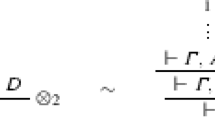Abstract
Monoidal algebraic structures consist of operations that can have multiple outputs as well as multiple inputs, which have applications in many areas including categorical algebra, programming language semantics, representation theory, algebraic quantum information, and quantum groups. String diagrams provide a convenient graphical syntax for reasoning formally about such structures, while avoiding many of the technical challenges of a term-based approach. Quantomatic is a tool that supports the (semi-)automatic construction of equational proofs using string diagrams. We briefly outline the theoretical basis of Quantomatic’s rewriting engine, then give an overview of the core features and architecture and give a simple example project that computes normal forms for commutative bialgebras.
Access this chapter
Tax calculation will be finalised at checkout
Purchases are for personal use only
Similar content being viewed by others
Notes
- 1.
Non-linear term rewriting can be encoded by introducing special ‘copy’ and ‘delete’ nodes which obey certain naturality conditions. However, when \(\otimes \ne \times \), these don’t exist in general.
References
Abramsky, S., Coecke, B.: A categorical semantics of quantum protocols. In: LICS 2004, pp. 415–425. IEEE Computer Society (2004)
Baez, J.C., Erbele, J.: Categories in control (2014). arXiv:1405.6881
Bonchi, F., Sobociński, P., Zanasi, F.: Interacting bialgebras are frobenius. In: Muscholl, A. (ed.) FOSSACS 2014 (ETAPS). LNCS, vol. 8412, pp. 351–365. Springer, Heidelberg (2014)
Bonchi, F., Sobociński, P., Zanasi, F.: Full abstraction for signal flow graphs. In: Principles of Programming Languages, POPL 2015 (2015)
Clark, S., Coecke, B., Sadrzadeh, M.: Mathematical foundations for a compositional distributed model of meaning. Linguist. Anal. 36, 1–4 (2011)
Coecke, B., Duncan, R.: Interacting quantum observables: categorical algebra and diagrammatics. New J. Phys. 13(4), 043016 (2011)
Danos, V., Feret, J., Fontana, W., Harmer, R., Krivine, J.: Abstracting the differential semantics of rule-based models: exact and automated model reduction. In: LICS (2010)
Dixon, L., Kissinger, A.: Open-graphs and monoidal theories. Math. Struct. Comput. Sci. 23, 308–359 (2013)
Duncan, R., Lucas, M.: Verifying the steane code with quantomatic. In: Quantum Physics and Logic, vol. 2013 (2013)
Duncan, R., Perdrix, S.: Rewriting measurement-based quantum computations with generalised flow. In: Abramsky, S., Gavoille, C., Kirchner, C., Meyer auf der Heide, F., Spirakis, P.G. (eds.) ICALP 2010. LNCS, vol. 6199, pp. 285–296. Springer, Heidelberg (2010)
Grefenstette, E., Sadrzadeh, M.: Experimental support for a categorical compositional distributional model of meaning. In: Proceedings of the Conference on Empirical Methods in Natural Language Processing (2011)
Grov, G., Kissinger, A., Lin, Y.: Tinker, tailor, solver, proof. In: UITP (2014)
Hillebrand, A.: Quantum protocols involving multiparticle entanglement and their representations in the ZX-calculus. Master’s thesis, Oxford University (2011)
Johansson, M., Dixon, L., Bundy, A.: Conjecture synthesis for inductive theories. J. Autom. Reason. 47(3), 251–289 (2011)
Joyal, A., Street, R.: The geometry of tensor calculus I. Adv. Math. 88(1), 55–112 (1991)
Kissinger, A.: Pictures of Processes: Automated Graph Rewriting for Monoidal Categories and Applications to Quantum Computing. Ph.d. thesis, Oxford (2012)
Kissinger, A.: Synthesising graphical theories (2012). arXiv:1202.6079
Kissinger, A., Merry, A., Soloviev, M.: Pattern graph rewrite systems. In: Proceedings of DCM (2012)
Kissinger, A., Quick, D.: Tensors, !-graphs, and non-commutative quantum structures. In: QPL 2014, vol. 172 of EPTCS, pp. 56–67 (2014)
Kissinger, A., Zamdzhiev, V.: !-graphs with trivial overlap are context-free. In: Proceedings Graphs as Models, GaM 2015, London, UK, pp. 11–12 , April 2015
Melliès, P.-A.: Local states in string diagrams. In: Dowek, G. (ed.) RTA-TLCA 2014. LNCS, vol. 8560, pp. 334–348. Springer, Heidelberg (2014)
Merry, A.: Reasoning with !-graphs. Ph.d. thesis, Oxford University (2013)
Michaelson, G., Grov, G.: Reasoning about multi-process systems with the box calculus. In: Zsók, V., Horváth, Z., Plasmeijer, R. (eds.) CEFP. LNCS, vol. 7241, pp. 279–338. Springer, Heidelberg (2012)
Penrose, R.: Applications of negative dimensional tensors. In: Dowling, T.A., Penrose, R. (eds.) Combinatorial Mathematics and its Applications, pp. 221–244. Academic Press, San Diego (1971)
Rensink, A.: The GROOVE simulator: a tool for state space generation. In: Pfaltz, J.L., Nagl, M., Böhlen, B. (eds.) AGTIVE 2003. LNCS, vol. 3062, pp. 479–485. Springer, Heidelberg (2004)
Schürr, A.: PROGRESS: a VHL-language based on graph grammars. In: Ehrig, H., Kreoswki, H.-J., Rozenberg, G. (eds.) Graph Grammars and Their Application to Computer Science. LNCS, vol. 532. Springer, Heidelberg (1991)
Sobociński, P.: Representations of petri net interactions. In: Gastin, P., Laroussinie, F. (eds.) CONCUR 2010. LNCS, vol. 6269, pp. 554–568. Springer, Heidelberg (2010)
Taentzer, G.: AGG: A graph transformation environment for modeling and validation of software. In: Pfaltz, J.L., Nagl, M., Böhlen, B. (eds.) AGTIVE 2003. LNCS, vol. 3062, pp. 446–453. Springer, Heidelberg (2004)
Acknowledgements
In addition to the two authors, Quantomatic has received major contributions from Alex Merry, Lucas Dixon, and Ross Duncan. We would also like to thank David Quick, Benjamin Frot, Fabio Zennaro, Krzysztof Bar, Gudmund Grov, Yuhui Lin, Matvey Soloviev, Song Zhang, and Michael Bradley for their contributions and gratefully acknowledge financial support from EPSRC, the Scatcherd European Scholarship, and the John Templeton Foundation.
Author information
Authors and Affiliations
Corresponding author
Editor information
Editors and Affiliations
Rights and permissions
Copyright information
© 2015 Springer International Publishing Switzerland
About this paper
Cite this paper
Kissinger, A., Zamdzhiev, V. (2015). Quantomatic: A Proof Assistant for Diagrammatic Reasoning. In: Felty, A., Middeldorp, A. (eds) Automated Deduction - CADE-25. CADE 2015. Lecture Notes in Computer Science(), vol 9195. Springer, Cham. https://doi.org/10.1007/978-3-319-21401-6_22
Download citation
DOI: https://doi.org/10.1007/978-3-319-21401-6_22
Published:
Publisher Name: Springer, Cham
Print ISBN: 978-3-319-21400-9
Online ISBN: 978-3-319-21401-6
eBook Packages: Computer ScienceComputer Science (R0)




